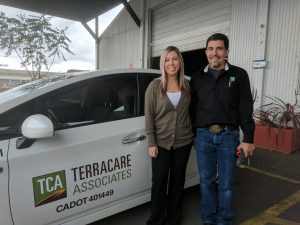Thanksgiving is a wonderful time to reflect and appreciate those that are important to us. We would like to take this opportunity to express our gratitude to you, our clients. It is a pleasure to maintain your property and keep it in pristine condition. We are very thankful for you and your continued business with us. We look forward to many more years working alongside you and continuing to build our relationship with you.
Category: Commercial Landscape Maintenance
What the Farmer’s Almanac predicts for this Winter
It’s almost time to say goodbye to fall, are you ready? By doing the research for your region’s weather predictions now, you will be able to adjust and prepare for any potential surprises that could be heading towards your commercial landscape property. For these forecasts we chose to use The Farmer’s Almanac. The Farmer’s Almanac has been around for about 200 years. It also claims that the forecasts it provides are 80 to 85 percent accurate.
Colorado:
 Colorado’s winter weather predictions state that it will be a cold winter with moderate amounts of snowfall. However, the winter will not be as harsh as usual. On top of that, The Farmer’s Almanac states that “our forecasts are pointing to a return to more normal winter conditions in regard to both temperatures and precipitation.” That’s not to say there won’t be the sporadic heavy winter storm coming in from the Pacific or pushing south from western Canada. These storms should be “balanced out by spells of dry and mild weather,” the forecast says.
Colorado’s winter weather predictions state that it will be a cold winter with moderate amounts of snowfall. However, the winter will not be as harsh as usual. On top of that, The Farmer’s Almanac states that “our forecasts are pointing to a return to more normal winter conditions in regard to both temperatures and precipitation.” That’s not to say there won’t be the sporadic heavy winter storm coming in from the Pacific or pushing south from western Canada. These storms should be “balanced out by spells of dry and mild weather,” the forecast says.
Northern California:
The Farmer’s Almanac predicts that Northern California will be cooler than normal with rainfall above normal. The coldest periods for Northern California will take place in late November into early December and as well as early February.
Southern California:
For Southern California, The Farmer’s Almanac states that it will be a very average winter for the area. The Farmer’s Almanac states that it will be mild and that you shouldn’t expect anything out of the ordinary for the area. Additionally, Southern California should anticipate average precipitation throughout the winter months.
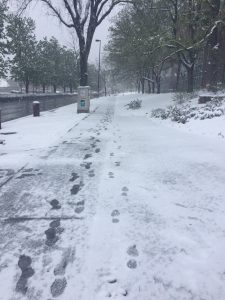 Texas:
Texas:
According to The Farmer’s Almanac, Texas will have a winter that is colder than normal. The region should also expect above- normal precipitation. The coldest parts of the winter season will be from late November into early December, from late December into early January, and in early February. Snowfall in Texas’ region will be near to above normal. Most snow will come in late December and early to mid-February.
It is not too late to get help with your snow removal needs. Send us a note or give us a call, we’ll get back to you with a proposal and estimate for how we can help you.
Benefits of Native Grass on Commercial Properties
As a property owner, the sustainability of the landscape is essential in not only saving money, but also providing a lasting impact on the environment. One factor that you might not have considered when thinking about sustainability is planting native grass. The word “native” means that the plant is indigenous to the area and can thrive without human contributions such as fertilizers and other lawn care treatments. Along with that native grass has many other benefits to a commercial landscape property, below are a few of those benefits.
Reduces heat
Lawns reduce environmental heating through cooling evaporation. On sunny days, air temperatures over lawns stay 10 to 15 degrees Fahrenheit cooler than air over asphalt or concrete. The resulting cooler air temperature means lower cooling costs for your building.
Curb appeal
 Green spaces make your property more attractive and increase its value. On average, buyers are willing to pay 11 percent more than asking price for a well-landscaped property. On top of that, customers spend more time and money when businesses have attractive landscaping. Adding grass to your property not only attracts customers, it also makes a commercial landscape property more attractive to potential employers and decreases turnover.
Green spaces make your property more attractive and increase its value. On average, buyers are willing to pay 11 percent more than asking price for a well-landscaped property. On top of that, customers spend more time and money when businesses have attractive landscaping. Adding grass to your property not only attracts customers, it also makes a commercial landscape property more attractive to potential employers and decreases turnover.
Stress reduction
Many studies prove that exposure to natural greenery reduces stress, lowers blood pressure, reduces muscle tension, improves attention and increases feelings of happiness. People who work in an environment with a view of nature have been found to recover from stress more quickly and experience less job pressure and greater job satisfaction. Exposure to nature has even been shown to increase work productivity. An investment in green space is a positive investment in your company.
Reduces soil erosion
Native grass has an extensive root system that locks soil in place to protect against wind and water. A single grass plant can have up to 300 miles of erosion-controlling roots. Gardens and other types on landscapes can experience up to 600 times more erosion than natural lawns, meaning more money shelled out by property owner’s for maintenance.
Purifies air and improves air quality
Approximately 12 million tons of impurities are absorbed from the air by turf grass each year. One these impurities is the greenhouse gas carbon dioxide. U.S. lawns alone capture an estimated 5% of the atmosphere’s carbon dioxide annually. Grass absorbs these impurities and moves them to the root zone where soil microbes help break down pollutants. Growing natural grass on your commercial property is a great way to decrease your business’s carbon footprint.
Produces oxygen
Grass is a living organism, meaning it takes in carbon dioxide and releases oxygen into the atmosphere. A lawn measuring 2,500 square feet generates enough oxygen to meet the daily needs of a family of four.
Contact the experts at Terracare Associates for your commercial landscaping needs today.
Scary bugs- or are they?
Most commercial landscape property owners are concerned about the effects that insects and other pests might have on the plants and trees on your property. Web worms in your trees, chinch bugs in your St. Augustine grass, and other insects can cause severe damage. But not all insects are detrimental to your landscaping. There are several “good bugs” that beneficial to the plants and trees on your property.
Scary Bugs
To understand why some bugs are beneficial to have on your commercial landscape property, you must first learn which bugs are harmful.
Aphids: This small insect, with its piercing and sucking mouth, is a common pest to many species of roses. Aphids suck the sap from plants, causing dried and damaged leaves. You will most often find aphids on roses, crepe myrtles, and pecan trees.
Chinch bugs: Another type of sucking insects that feed on turf grass, especially St. Augustine. They inject the grass with their toxic saliva, which causes the turf grass to wilt and die.
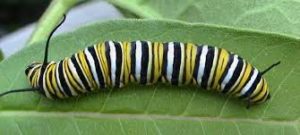 Caterpillars: Caterpillars also include hornworm and spring cankerworm. While they are not considered to be harmful to most plants, their feeding on the leaves and flowers of your plants will mar the look of your landscaping.
Caterpillars: Caterpillars also include hornworm and spring cankerworm. While they are not considered to be harmful to most plants, their feeding on the leaves and flowers of your plants will mar the look of your landscaping.
Grub worms: These fat white worms are most prevalent in hot summer months. They feed on the roots of turf grass. Dead patches in your St. Augustine, Bermuda, zoysia, or buffalo grass might be evidence of the presence of grub worms.
Good Bugs
There is an army of insects in the soil and flying around your property that can help with the control of harmful pests. By feeding on harmful pests like aphids, caterpillars, grubs, and soft-bodied insects, these bugs are nature’s own pest control system.
How are some insects beneficial? Honeybees and other insects are a vital part of the pollination of many species of flowers and plants. Predatory insects like lady bugs and soldier bugs feed on many species of harmful pests. Parasitic insects like spiders lay their eggs inside or on top of pests, including insects and grubs, using them as food for their larvae.
 Ladybugs: Adults ladybug beetles and their larvae love aphids, especially the aphids that often infest roses. They also feed on the scale insects, mealy bugs, mites and powdery mildew that can damage your plants.
Ladybugs: Adults ladybug beetles and their larvae love aphids, especially the aphids that often infest roses. They also feed on the scale insects, mealy bugs, mites and powdery mildew that can damage your plants.
Lacewings: Also known as aphid lions, these tiny insects with delicate wings feed on aphids, mealy bugs, scale and mites. Just one lacewing larva can eat more than 100 insects in a single day.
Braconid wasps: These non-stinging wasps feed on web worms, horn worms, caterpillars and other grubs.
 Spiders: It may be hard to believe, but most of the 3,000 species of North American spiders are actually helpful to your landscape. Spiders are predatory insects and feed on aphids, other spiders, beetles, mites and even fire ants.
Spiders: It may be hard to believe, but most of the 3,000 species of North American spiders are actually helpful to your landscape. Spiders are predatory insects and feed on aphids, other spiders, beetles, mites and even fire ants.
Contact Terracare Associates to find out how to control harmful landscape pests on your property.
Mario Ramos- Thank you for your service
 Mario Ramos is like no other, with his 21 years of service with TCA, he continues to show exemplary service every day on every job. He does this because he cares. Mario is an invaluable part of the Colorado landscape operations team here at Terracare Associates. He is a member of the field leadership team, taking care of the Fairmount Cemetery and is responsible for deploying field crews, prioritizing projects, making recommendations on maintenance improvements and handling all on-site emergencies. Each Memorial Day, Mario and his team take meticulous care of the hundreds of veteran grave sites. To make this magic happen all year, he and the account managers have an open book policy with field leadership teams to ensure excellent customer service. Mario is always loyal dedicated to everything he does. Nate Adams, Colorado landscape branch manager at TCA, says “I am extremely lucky to be able to work with Mario. He brings a new level of professionalism, and a get it done attitude unlike any I have ever seen.” We are so proud to have Mario as a member of the Terracare team!
Mario Ramos is like no other, with his 21 years of service with TCA, he continues to show exemplary service every day on every job. He does this because he cares. Mario is an invaluable part of the Colorado landscape operations team here at Terracare Associates. He is a member of the field leadership team, taking care of the Fairmount Cemetery and is responsible for deploying field crews, prioritizing projects, making recommendations on maintenance improvements and handling all on-site emergencies. Each Memorial Day, Mario and his team take meticulous care of the hundreds of veteran grave sites. To make this magic happen all year, he and the account managers have an open book policy with field leadership teams to ensure excellent customer service. Mario is always loyal dedicated to everything he does. Nate Adams, Colorado landscape branch manager at TCA, says “I am extremely lucky to be able to work with Mario. He brings a new level of professionalism, and a get it done attitude unlike any I have ever seen.” We are so proud to have Mario as a member of the Terracare team!
The Quick, Easy Guide to Build a Bat House
When bats are brought up in conversation, most people’s immediate thought is Halloween. The spooky holiday may give these creatures a scary rap when actually they are very beneficial to your commercial landscape property. These furry, flying, nocturnal animals are not only known for being pollinators, they also are great for pest management.
The United States has over 40 species of bats and every one of those is helpful to your property. Bats are amazing for pollination; in fact, they pollinate over 500 species of flowers. In addition to that, they are some of nature’s best form of pest control. Bats are known to consume anywhere from 100 to 600 bugs per hour, which can lead to a decrease in pesticide use and save you money.
To attract these bats to your commercial landscape property one of the best ways is to build a bat house. A bat house simulates their natural habit and encourages a bat to roost on your property. Below are the materials and steps to take to construct a bat house as recommended by hobbyfarms.com:
Materials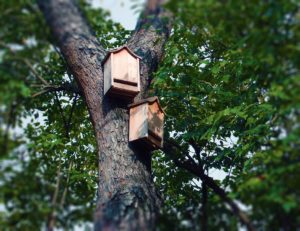
- 26½- by 24-inch piece 1/2-inch AC, BC or T1-11 outdoor-grade plywood (backboard)
- 5- by 24-inch piece 1/2-inch AC, BC or T1-11 outdoor-grade plywood (landing area)
- 16½- by 24-inch piece 1/2-inch AC, BC or T1-11 outdoor-grade plywood (front board)
- 1-pint dark, water-based stain, exterior grade
- 1 1×2 pine furring strip in 24-inch length
- 2 1×2 pine furring strips in 20½-inch lengths
- 1 tube of paintable latex caulk
- 20 to 30 1-inch exterior-grade screws
- 1-pint water-based primer, exterior grade
- 1 quart flat, water-based paint or stain, exterior grade
- 1×4 board in 28-inch length (optional, but highly recommended for roof)
- black asphalt shingles or galvanized metal (optional)
- 6 to 10 7/8-inch roofing nails (if using shingles or metal roofing)
Steps
- Roughen inside of backboard and landing area by cutting horizontal grooves with a sharp object or saw. Space grooves 1⁄4 inch to 1⁄2 inch apart, cutting 1⁄32 inch to 1⁄16 inch deep.
- Apply two coats of dark, water-based stain to interior surfaces. Do not use paint, as it will fill grooves.
- Attach furring strips to inside of backboard using 1-inch screws, caulking first. Start with 24-inch piece at top and space each additional strip at 3/4-inch intervals. This will be the roost chamber.
- Starting with the top furring strip, attach front board to furring strips using 1-inch screws (caulk first). Leave 1⁄2-inch vent space between top and bottom front pieces.
- Caulk all outside joints to further seal roost chamber.
- Attach roof (optional, but highly recommended) with 1-inch screws.
- Apply three coats of flat stain or paint to the exterior. Use primer for first coat.
- Cover roof with shingles or galvanized metal (optional) using roofing nails.
- Mount on building or other structure. South or east sides usually work best.
Employee Spotlight: Sergio Atayde
Sergio Atayde has been working his way up with the San Jose TCA branch for the past two years. He is currently a production supervisor/field supervisor maintaining many properties throughout San Jose. He started working in the landscape industry over 20 years ago and has held multiple positions including an account manager and an IRR tech. Eva Sarracco, account manager at the San Jose branch, said, “he takes pride in his work and is always willing to go the extra mile; (he) understands the importance of prompt follow-up, attention to detail is a very good communicator and is very reliable.” This desire to go the extra mile can be seen in the way he supervises. Sergio always tries to set a good example for his crew, through his hard work, he empowers them to do their best. Sergio takes the extra steps to help others to succeed, this, in turn, leads to top-notch quality work by his crew. In his free time, he loves being with his family including his son and daughter. Thank you, Sergio, we appreciate all that you’ve done!!
Fall Tree Pruning and Planting
Fall is a great time to plant and prune your trees. The months of cool fall and winter temperatures give newly planted trees and shrubs time to establish their roots before the hot summer weather returns.
Fall Tree Pruning
The goal of fall tree pruning is to improve the growing conditions for the next year’s growing season. After the spring and summer growing seasons, overgrown branches and limbs can cause damage to your property. Removing damaged or diseased limbs will not only contribute to the overall health of the tree, it will also help prevent falling tree limbs. Trees should be pruned to allow “room” for sunlight and breezes to naturally flow through. When done properly, pruning allows more light to shine through the branches and reduces the need for pesticides.
Fall Tree Planting
Did you know that tree roots will grow when the temperature is above 40 degrees? That means tree roots can continue growing during the milder fall and winter weather. This gives them the time to gain the strength they need to deal with hot summers.
Choosing the Right Tree for Your Property
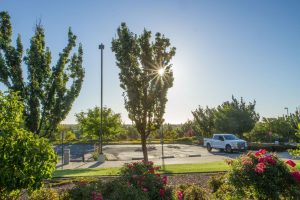 Consult with a professional landscaper before deciding which trees and shrubs to plant. A knowledgeable landscape professional can help you select the right plants for your property by helping you answer these questions:
Consult with a professional landscaper before deciding which trees and shrubs to plant. A knowledgeable landscape professional can help you select the right plants for your property by helping you answer these questions:
What type of tree do you want or need?
Do you want an ornamental tree with colorful flowers and foliage or would a shade tree be a better fit for your property?
What size tree will fit in the desired area? Consider the mature height and width of the tree and if it will work in your landscape.
Pay specific attention to the soil conditions, light and water requirements of the tree or shrub.
Terracare Associates specializes in landscape maintenance for commercial properties throughout the western United States. We manage the landscapes of hundreds of retail sites, homeowner associations, multi-family complexes, industrial projects, hotels, municipalities and commercial office campuses.
Winterizing Your Property’s Irrigation
With colder temperatures fast approaching it’s time to think about winterizing your property’s irrigation system. This will prevent water loss and icy walkways. Prepare your irrigation system for winter by performing a system audit to check for potential problems.
Step 1: Check the sprinkler heads
Check for missing or broken sprinkler heads and replace any broken sprinkler heads.
Remove clogged heads and clean the filter or replace, if necessary.
Adjust tilted heads to ensure that they are not spraying in the wrong direction.
Replace all leaky valves in the valve box to prevent leaking water and high water costs.
Remove and trim back grass, shrubs or other plants that cause misdirected or blocked spray pattern and obstruction of raising the heads.
Adjust the sprinkler heads to avoid spraying sidewalks, driveways or other hardscapes. This will not only save money on watering costs, but it will also prevent icy, slippery pedestrian walkways.
Step 2: Consider the watering needs of cool season plants
During colder weather many cool season plants need less water. Turf grasses like St. Augustine and Bermuda grass go dormant during the winter months. You need to adjust the timing and zone settings on your irrigation system to prevent over watering.
Step 3: Use weather-based smart controllers
 Weather-based controllers are designed to adjust your irrigation schedules based on weather conditions. These climate-based systems gather local weather information and factor in your exact landscape to make irrigation run-time adjustments so your landscape receives the appropriate amount of water.
Weather-based controllers are designed to adjust your irrigation schedules based on weather conditions. These climate-based systems gather local weather information and factor in your exact landscape to make irrigation run-time adjustments so your landscape receives the appropriate amount of water.
Step 4 Install rain/freeze sensors
Contact the irrigation system specialists at Terracare Associates to ensure your property is ready for winter.
Terracare Associates voted a favorite by San Diego Union-Tribune
 Terracare Associates has been voted one of the Best Commercial Landscape providers in San Diego County by the San Diego Union- Tribune readers!
Terracare Associates has been voted one of the Best Commercial Landscape providers in San Diego County by the San Diego Union- Tribune readers!
Terracare Associates is honored to be represented on such a renowned list as San Diego’s Best Union-Tribune Readers Poll. We are very proud to serve San Diego region and we look forward to continuing to serve this community.
Each year San Diego’s Union- Tribune reaches out to their readers and asks them to vote in more than 175 categories for their selection of the “best of the best” in San Diego County. This year, the Tribune added a new component and recognized businesses with votes to include the top vote getters the “Best” and the “Favorites,” businesses receiving votes from readers.
For more information, see (link)
About Terracare Associates
Terracare Associates, LLC is a recognized leader in outdoor maintenance in the Western United States. For more than 30 years, our certified and experienced staff works during all seasons to improve landscapes, parks, roadways and infrastructure for beautiful, safe and sustainable outdoor environments. We are headquartered in Littleton, Colorado, and are proud to serve Colorado, Northern and Southern California and Texas.

